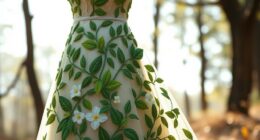Adding dried flowers to your space gives you arrangements that last much longer than fresh bouquets, offering ongoing beauty and charm with minimal effort. Dried flowers resist fading and wilting, making them a low-maintenance, durable decoration for homes or offices. Proper preservation techniques help maintain their vibrant colors and shapes over time. If you want to discover more about selecting the best flowers and methods to keep your arrangements stunning, keep exploring for tips and ideas.
Key Takeaways
- Dried flower arrangements offer lasting beauty and require minimal maintenance compared to fresh bouquets.
- Proper preservation techniques like air drying, silica gel, or pressing ensure flowers retain color and shape.
- Selecting suitable flower types and harvesting at peak bloom enhances vibrancy and longevity.
- Seasonal awareness helps choose flowers that dry well and match seasonal aesthetics.
- Dried arrangements provide durable, year-round decor that outlasts fresh flowers in beauty and durability.

Dried flower arrangements have become a popular choice for adding lasting beauty and charm to any space. Unlike fresh flowers that fade within days, dried flowers offer a durable, low-maintenance alternative that can brighten your home or office for months or even years. To keep your dried arrangements looking their best, understanding preservation techniques is essential. Properly drying and maintaining your flowers ensures they retain their color, shape, and texture over time. Techniques such as air drying, using silica gel, or pressing flowers each have their advantages, depending on the type of flower and the look you desire. For example, air drying is simple and effective for roses and lavender, while silica gel can preserve more delicate blooms with vibrant colors. Mastering these preservation techniques allows you to create arrangements that stand the test of time, maintaining their beauty regardless of seasonal changes. Additionally, the choice of flower type can influence how well flowers hold their color and form during the drying process. Seasonal variations profoundly influence the types of flowers suitable for drying and the colors they retain. Some flowers, like sunflowers and daisies, dry beautifully and hold their cheerful hues, making them perfect for summer or fall arrangements. Others, such as certain roses or peonies, may fade or darken when dried, so choosing the right flowers for each season ensures your arrangements stay vibrant. Understanding these seasonal variations helps you select the best blooms for your desired aesthetic, whether you want warm autumn tones or cool winter whites. Additionally, the timing of harvesting flowers can impact their drying quality; picking blooms at their peak ensures they dry with ideal color and form. By aligning your preservation techniques with seasonal variations, you can craft arrangements that reflect the seasons beautifully and last through changing weather.
Frequently Asked Questions
How Long Do Dried Flower Arrangements Typically Last?
Dried flower arrangements usually last between 1 to 3 years, depending on preservation techniques used. You can extend their lifespan by keeping them away from direct sunlight and humidity, which helps preserve color retention. Proper handling and gentle cleaning also prevent damage, ensuring your arrangement remains beautiful longer. With the right care, you’ll enjoy these lasting decorations for years, adding natural charm without the worry of wilting like fresh bouquets.
What Are the Best Storage Conditions for Dried Flowers?
Imagine your dried flowers as delicate treasures that could fade at the blink of an eye! To keep them vibrant, you must master humidity control—keep it low to prevent mold and decay—and minimize light exposure, especially direct sunlight, which can bleach their colors. Store them in a cool, dry place, away from humidity and harsh light, and your dried arrangements will stay stunning for years, almost forever.
Can Dried Flowers Be Used Outdoors Without Fading?
Dried flowers can be used outdoors, but their outdoor durability depends on proper flower preservation. To prevent fading and damage, keep them away from direct sunlight, rain, and humidity. Applying a protective spray can enhance their resilience. While they won’t last as long outside as indoors, with care, dried flowers can add natural beauty to your outdoor space and maintain their charm longer when protected from harsh elements.
Are Dried Flowers Safe for Allergy Sufferers?
You might wonder if dried flowers are allergy-safe. Generally, dried flowers are considered hypoallergenic options because they don’t produce pollen like fresh blooms. However, some dried flowers can still trigger allergies due to dust or mold if not stored properly. To guarantee allergy safety, choose dried flowers known for being hypoallergenic, keep arrangements clean, and avoid dusty or damp environments. Always check specific flower types for potential allergen risks.
How Do I Refresh Dried Flower Arrangements?
Imagine your vintage flower arrangement as a silent film, longing for a refresh. To revive it, gently dust the dried flowers and use preservation techniques like light misting or silica gel. Avoid overwatering. You can also rearrange or add new dried blooms for decorating ideas. This keeps your arrangement vibrant and lasting, turning it into a timeless piece that captures the charm of bygone eras.
Conclusion
Dried flower arrangements bring lasting beauty to your space, outlasting fresh bouquets and requiring less fuss. With a touch of vintage charm, they add character and warmth to any room, making you feel like you’ve stepped into a timeless garden. So, go ahead—embrace the elegance of dried flowers and create arrangements that stand the test of time. After all, who wouldn’t want a bit of floral magic that’s as enduring as a well-loved novel?










